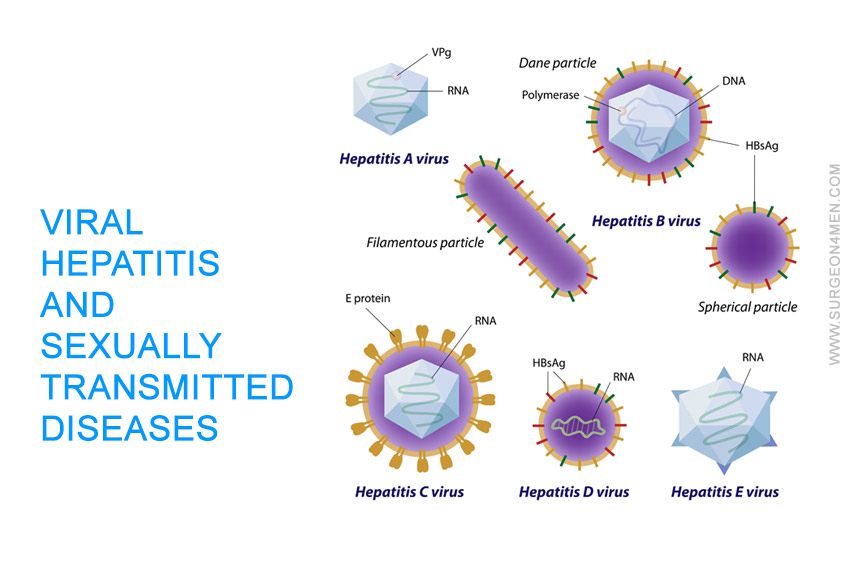Viral Hepatitis and Sexually Transmitted Diseases
The most common mode of viral transmission is via contact with infected needles as well as contaminated body secretions such as semen, genital fluids, saliva and respiratory droplets. Viral hepatitis is caused by a group pf viruses that holds a special propensity for liver cells. This includes; Hepatitis A, B, C and D. Most frequently reported varieties that are transmitted via sexual contract are Hepatitis B and C.
What are Different Types of Hepatitis Viruses?
According to the latest data reported by Centers for Disease Control and Prevention (1); Hepatitis C is the most frequently reported variety within the United States and is transmitted via sexual contact with an infected person. Partly, this high prevalence is attributed to a lack of vaccine unlike Hepatitis B.
Listed below is a brief account of infection caused by each variety of viral hepatitis:
Hepatitis A is a non-sexually transmitted infection that is attributed to more than 3,050 acute cases of viral hepatitis across the United States. The incidence rate is 0.5 cases per 100,000 (1). It is transferred through contaminated fecal-oral contact (refers to oral-anal interaction directly or indirectly via articles or body parts in contact with the diseased person). Even a minor amount of virus can cause serious infection; however, there is no risk of chronic infection or permanent liver damage. Classic symptoms of Hepatitis A infection are:
- Upper gastrointestinal symptoms; such as nausea, vomiting
- Nom-specific symptoms such as anorexia, fever, malaise
- Signs of liver inflammation such as jaundice, dark urine, yellowing of sclera and abdominal pain
Hepatitis B:
Hepatitis B is a sexually transmitted variety of Hepatitis viruses. Based on the latest data reported by CDC (2), a total of 2,895 cases of HBV were reported last year; attributing to an overall incidence rate of 0.9 cases per 100,000.
It is known as HBV and can be transferred via sexual contact with an infected person since large quantities of viral products are secreted in the bodily secretions such as semen, saliva and vaginal fluids. HBV can be transferred via both oral and anal sex. However, just like other sexually transmitted diseases, there is no risk of viral transmission via hugging, dry kissing and hand holding. The chances of transmission through deep kissing are minimal but still exists (especially if the infected person has cuts in mouth or uses orthodontic brackets). The risks of having HBV are least if you have only one sexual partner but it eventually increases as the number of sexual partners increases.
Hepatitis C:
Just like HBV, Hepatitis C virus is also transmitted sexually via sexual contact with an infected person. In addition, viral products are also transmitted via infected blood. If you have history of any disease transmitted sexually or if you have more than five sex partners or you have ever had sex with a prostitute, then the chances of you having HCV increases significantly. Unlike HAV, both HBV and HCV are known to cause chronic liver infection and permanent liver damage. According to latest data, more than 75 to 85% cases of HCV infection culminate in chronic liver illness.
What Else Should You know About the Viral Hepatitis as an STD?
Although, one way to limit the risk of infection is to ensure that your sexual partner has no hepatitis symptoms, but unfortunately there are no clear symptoms of infection (especially in the early course of infection).
Some signs that may indicate the presence of sexually transmitted hepatitis virus include:
- Poor appetite
- Fever with fatigue and nausea
- Pain in joints or abdomen
- Bowel movements (clay colored)
The only way to clearly determine whether your partner has hepatitis is to have blood tests.
How to Minimize the Risk of Contracting Sexually Transmitted Viral Hepatitis?
- The risk of viral transmission increases significantly if the person has cuts, scratches or acute trauma.
- Among different variants of sexual interactions; anal sex has been associated with the highest risk of transmission of HBV and HCV. Oral-anal type of sex can also be risky at times. These risks can be controlled by taking the necessary precautions; precautions can be taken by any person who is sexually active and not in any mutually steady relationship.
- Some precautions include; use of condoms (also female condoms), dental dam, use of finger cots in between of your own and the partner’s body fluids including blood.
- A person can also get vaccinated as a precaution for hepatitis A and B, unfortunately no vaccines have been introduced for hepatitis C.
- The possibility of transmitting hepatitis through sex toys and vibrators is relatively high due to the existence of hepatitis B outside the body for even more than a week. Use of vibrator/ sex toys after immersing in hot water can reduce the risks. But the best thing is to get your partner vaccinated and do not use these products until then.
- Doctors suggest using condoms that are plain because they are relatively more effective than the scented and flavored ones. Use of condoms result satisfactory in 99% cases unless you and your partner are in monogamous relationship.
There is least possibility of transmitting hepatitis by kissing only; deep kissing that involves exchanging saliva in huge amount might cause hepatitis B. the condition can get worse and chances of transmission increase if the diseased person has cuts or scratches in mouth.
References:
- http://www.cdc.gov/hepatitis/statistics/
- Moorman, A. C., Gordon, S. C., Rupp, L. B., Spradling, P. R., Teshale, E. H., Lu, M., … & Chronic Hepatitis Cohort Study Investigators. (2012). Baseline characteristics and mortality among people in care for chronic viral hepatitis: the chronic hepatitis cohort study. Clinical infectious diseases, cis815.
- Mohd Hanafiah, K., Groeger, J., Flaxman, A. D., & Wiersma, S. T. (2013). Global epidemiology of hepatitis C virus infection: New estimates of age‐specific antibody to HCV seroprevalence. Hepatology, 57(4), 1333-1342.
